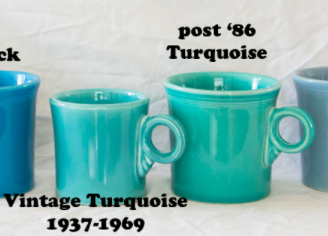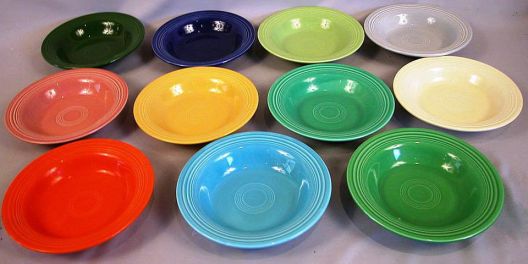
History
1936-1973
Fiestaware comes in nearly fifty colors, if you include the three Ironstone firings and original and post-86 colors as separate colors. While most people say there are six original colors, Homer Laughlin only put five colors into production in 1936, and only added turquoise in 1937, bringing the total to six. The first five are: original (radioactive) red, blue, green, yellow, and ivory. Collectors call the blue cobalt, the green light green, and ivory old ivory, in order to differentiate between the many different firings of similar colors. Yellow is the only color to survive the entire original four and a half decades.
After fifteen years, Homer Laughlin decided to change up their color line, marking the beginning of what is known as the 50’s colors. These 50’s colors are forest green, original rose, chartreuse, and gray. Several of the original six colors were cut, including blue (cobalt), green (light), and ivory. The 50’s colors are generally softer and more delicate than the original six. Rose and chartreuse have been recreated in the post 86 era, and while you can generally tell the difference between original rose and new rose, it takes a sharper eye to compare original and new chartreuse.
All of the 50’s colors were ended in 1959, and medium green was introduced in 1959, a color darker than original green and lighter than forest green. At this point, the color line up is original red, yellow, turquoise, and medium green. Production is down due to a trend in earthenware tones, and all colors except original red are retired in 1969. The three Fiesta Ironstone colors are introduced – Mango Red, Antique Gold, and Turf Green. Mango Red is essentially the same as original red, and Turf Green was similar in color to avocado green, which was popular at the time. Antique Gold matched a similarly popular color, but sales did not increase. In 1972, Fiesta closed it’s doors.
Of the original colors, original (radioactive) red and medium green are the two most coveted colors. While the amount of radiation in the ‘radioactive red’ isn’t dangerous to humans, it still makes an exciting piece and thus a coveted piece. As for medium green, while it was produced for a decade, Homer Laughlin produced a fewer number of pieces during that decade, so medium green (similar in color to John Deere green, so watch out for fake ‘medium green’ sales!) is the most valued of original and post 86 colors.
Post-86
In 1985, Bloomingdale’s approached Homer Laughlin about recreating an old dinnerware line, and decided that Fiesta was the most promising. They introduced new colors with the added benefit of being lead-free, something that most other dinnerware lines hadn’t embraced yet.
Post-86 Fiesta was an instant success. The first colors to be fired were white, black, rose, apricot, and cobalt blue. Colors were added and removed all the time, and occasionally, Homer Laughlin did limited runs of colors. The first limited run was Lilac, from 1993 to 1995. Lilac is the most sought after post-86 color. Sapphire was the shortest fired color, from 1996 to 1997, and was a Bloomingdale’s exclusive. Chartreuse was fired from 1997-1999, and is just a little bit brighter than the original color. Juniper were fired only from 1999-2001. The latest limited firing was marigold in 2011, and was fired for only 75 weeks for the 75th anniversary of Fiesta. Homer Laughlin produced “no more than 10,000 individually numbered pieces” of marigold.
In 1997, to commemorate their 500 millionth piece produced, Homer Laughlin produced five hundred raspberry presentation bowls, which were numbered. These are extremely rare, and can go from five thousand dollars to twenty thousand dollars or more, depending on the auction. They originally came with a certificate authenticating them, and the box top had the signature dancing lady. This is probably the second rarest piece in Fiesta production, with only the original turquoise onion soup bowl being rarer.
At this point, Homer Laughlin introduces one new color of Fiesta every year, and generally retires one (or two) colors at the same time. In 2018, the new color is a new purple: mulberry, and retired tangerine and claret, which will end production at the end of 2018.
Color Lineup
Original Colors
Post 86
- White: 1986-
- Black: 1986-2015
- Rose: 1986-2005
- Apricot: 1986-1998
- Cobalt Blue: 1986-
- Yellow: 1987-2002
- Turquoise: 1988-
- Periwinkle: 1989-2006
- Sea Mist: 1991-2005
- Lilac: 1993-1995
- Persimmon: 1995-2008
- Sapphire: 1996-2008
- Raspberry: 1997 (limited to 500 presentation bowls)
- Chartreuse: 1997-1999
- Pearl Gray: 1999-Dec 2001
- Juniper: 1999-Dec 2001
- Cinnabar: 2000-2010
- Sunflower: 2001-
- Plum: 2002-2015
- Shamrock: 2002-
- Tangerine: 2002-2018
- Scarlet: 2004-
- Peacock: 2005-2015
- Heather: 2006-2009
- Evergreen: 2007-2009
- Ivory: 2008-
- Chocolate: 2008-2012
- Lemongrass: 2009-
- Paprika: 2010-2017
- Marigold: 2011-2012 (75 Weeks)
- Flamingo: 2012-2014
- Lapis: 2013-
- Poppy: 2014-
- Sage: 2015-
- Slate: 2015-
- Claret: 2016-2018
- Daffodil: 2017-
- Mulberry: 2018-
Find the Masterlist of Color Checklists Here
Sources: TexasCooking, FiestaFactoryDirect (2)(3), Wikipedia, The Little Round Table, Happy Heidi








































